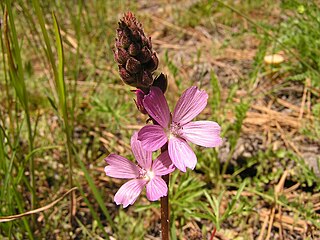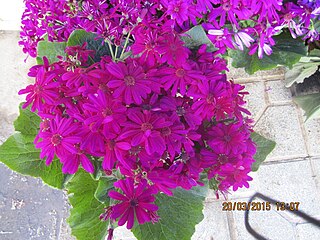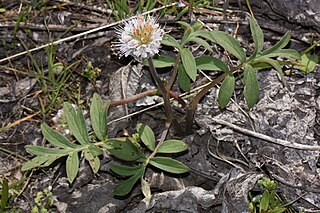
Sidalcea pedata, also called birdfoot checkerbloom or Big Bear checkerbloom, is a rare and endangered perennial herb of California. It blooms between May and July. However, it is an endemic species of California and only occurs in few places in the San Bernardino Mountains, primarily at Bear Valley, Bluff Lake. It grows at 1500–2100 m elevation in moist meadows to open woodlands and the unique pebble plain habitat of the area. Since Big Bear Valley is a resort destination, the birdfoot checkerbloom is threatened by development, vehicles and grazing.

Sidalcea is a genus of the botanical family Malvaceae. It contains several species of flowering plants known generally as checkerblooms or checkermallows, or prairie mallows in the United Kingdom. They can be annuals or perennials, some rhizomatous. They are native to West and Central North America.

Malva sylvestris is a species of the mallow genus Malva in the family of Malvaceae and is considered to be the type species for the genus. Known as common mallow to English-speaking Europeans, it acquired the common names of cheeses, high mallow and tall mallow as it migrated from its native home in Western Europe, North Africa and Asia through the English-speaking world.

Cineraria deltoidea is a perennial flowering plant of the family Asteraceae and the genus Cineraria which is also the closest known relative of the giant Dendrosenecio of East Africa.

Deutzia gracilis, the slender deutzia or Japanese snow flower, is a species of flowering plant in the hydrangea family Hydrangeaceae, native to Japan.
Nemophila breviflora is a species of flowering plant in the borage family known by the common names basin nemophila, Great Basin nemophila, and Great Basin baby-blue-eyes. It is native to southwestern Canada and the northwestern United States, where it generally grows in wooded and forested areas in thickets and moist streambanks.

Nemophila heterophylla is a species of flowering plant in the borage family known by the common name small baby blue eyes.

Pinguicula orchidioides is a perennial rosette-forming insectivorous herb native to Mexico and Guatemala. A species of butterwort, it forms summer rosettes of flat, succulent leaves up to 5 centimeters (2 in) long, which are covered in mucilaginous (sticky) glands that attract, trap, and digest arthropod prey. Nutrients derived from the prey are used to supplement the nutrient-poor substrate that the plant grows in. Uniquely among Pinguicula species from the Americas, p. orchidioides produces gemma-like basal buds which elongate into stolons and serve as a means of asexual reproduction. In the winter the plant forms a non-carnivorous rosette of small, fleshy leaves that conserves energy while food and moisture supplies are low. Single purple flowers appear between July and September on upright stalks up to 22 centimeters long.

Sidalcea covillei is an uncommon species of flowering plant in the mallow family known by the common names Owens Valley sidalcea, and Owens Valley checkerbloom. It is endemic to the Owens Valley of Inyo County, California, where it grows on alkali flats and in alkaline meadows and springs. While it is limited to this single valley, it is known from 42 sites there, and several populations are relatively large, but are greatly diminished by historical standards.

Sidalcea diploscypha is a species of flowering plant in the mallow family known by the common name fringed checkerbloom. It is endemic to California, where it grows in the woodlands and valleys of the central part of the state.

Sidalcea glaucescens is a species of flowering plant in the mallow family known by the common name waxy checkerbloom.

Sidalcea hickmanii is a species of flowering plant in the mallow family known generally by the common name chaparral checkerbloom.

Sidalcea malviflora is a species of flowering plant in the mallow family, known by the common names dwarf checkerbloom, Greek mallow, prairie mallow and dwarf checkermallow.

Sidalcea neomexicana is a species of flowering plant in the mallow family known by the common names salt spring checkerbloom, Rocky Mountain checker-mallow, and New Mexico checker.

Sidalcea oregana is a species of flowering plant in the mallow family known by the common name Oregon checkerbloom.

Sidalcea ranunculacea is a species of flowering plant in the mallow family known by the common name marsh checkerbloom and marsh checker mallow.

Sidalcea reptans is a species of flowering plant in the mallow family known by the common name Sierra checkerbloom and Sierra checker mallow.

Hydrophyllum capitatum, is a species of waterleaf known by the common name ballhead waterleaf. It is native to Western North America from British Columbia to Utah.
Struthiola tetralepis is a willowy shrublet of up to 30 cm (0.98 ft) high that is assigned to the family Thymelaeaceae. It has long straight branches that are initially hairy and are covered in leaves pressed against them. These leaves are small, overlapping, lance-shaped, sharply pointed, have a regular row of hairs along the margins, and 3-5 veins are visible on the outward facing surface. It has initially greenish yellow, later reddish brown flowers, each of which consists of a tube of about 1 cm (0.39 in) long with 4 lance-shaped, pointed sepal lobes and 4 yellow alternating petal-like scales. It flowers between October and February. It can be found in the southwest of the Western Cape province of South Africa. It is sometimes called cross capespray in English.

Kalanchoe sexangularis, also known as bushveld kalanchoe, six-angled kalanchoe, or red-leaved kalanchoe, is a species of the succulent genus Kalanchoe, in the family Crassulaceae that is native to Southern Africa.



















